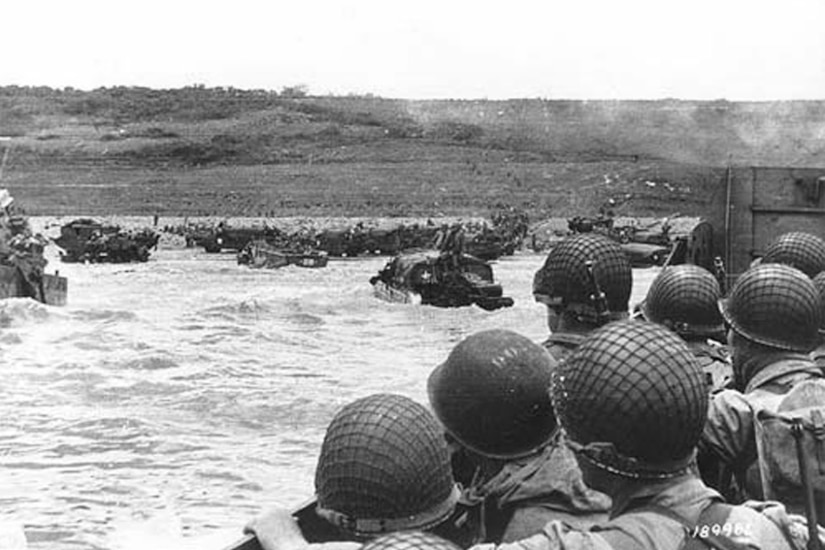On June 6, 1944, nearly 160,000 Allied troops landed along a heavily fortified, 50-mile stretch of French coastline in the historic operation known as D-Day. More than 9,000 Allied soldiers were killed or wounded on the beaches of Normandy, but by day’s end, the Allies had gained a foothold to begin liberating Europe.
DoD: When the ramp to his World War II landing craft slammed down onto Utah Beach, Army Cpl. Herman Zeitchik jumped out and dashed across the sand as deadly rounds were shot out from fortified bunkers.
 D-Day
D-Day
With the amphibious assault underway in the early morning of June 6, 1944, Zeitchik and other 4th Infantry Division soldiers — who were part of the first wave to land — desperately tried to find safe passage through the German-occupied beach.
“When the front of these landing crafts went down, we just took off,” said Zeitchik, now 93 years old. “We couldn’t see where to fire. We just had to get off the beach and try to find the rest of the unit.”
Along a 50-mile stretch of coastline in northern France, more than 160,000 Allied troops stormed Utah Beach and four other beaches that day to gain a foothold in continental Europe. By the end of the D-Day invasion, more than 9,000 of those Allied troops were either dead or wounded — the majority of them Americans.
While several in his unit were casualties, Zeitchik and others survived to push on into enemy territory and liberate Paris.
“There were so many of us coming ashore. I was just lucky,” he said today before attending a remembrance ceremony at the National World War II Memorial here that commemorated the 73rd anniversary of D-Day.
More than 5,000 ships and 13,000 aircraft were used in what is known as the largest-ever seaborne invasion. The massive operation would turn the tide against Nazi Germany forces entrenched across Europe.
“I don’t know that we could have ever done a better job of recreating what happened on this historic day back in 1944,” said Lt. Gen. Gary Cheek, director of the Army Staff. Speaking at the ceremony, Cheek said the heroics witnessed on D-Day helped to pave the way to an Allied victory in Europe while also giving Americans freedom for years to come.
“They stormed these beaches so we might stand here free and prosperous,” he said. “They were steadfast and loyal to the mission at hand and met their rendezvous with destiny head-on and they were successful.”
Total Chaos
Army Pvt. Arnald Gabriel recalled wading through the cold ocean water after his landing craft failed to make it all the way to Omaha Beach. “The water, believe it or not, in June was awfully cold, and that with the combination of fear, it was quite an experience,” he said. A machine gunner with the 29th Infantry Division, Gabriel described a how the chaotic scene unfolded.
“With the Air Force overheard, the Navy shelling [enemy positions], the enemy firing at you and we’re firing at them, it was just total chaos,” he said. “Nobody landed where they were supposed to. I landed way over to the left flank and ended up with the 1st [Infantry] Division. It took me a day to get back and find the 29th Division. It was that kind of chaos.”
After storming Omaha Beach, helping to liberate parts of France and earning two Bronze Stars with the Army, Gabriel later joined the Air Force as a band director. Before the war, he was in his high school band, and he always wanted to get back into music, he said. Music provided him comfort and kept his mind from dwelling too long on the memories of D-Day and other combat missions.
“The way I overcame my post-traumatic stress was to keep so busy that I had no time to look back,” he said before the ceremony.
Shortly after the war, he said, a lieutenant gave him the advice about keeping busy. It came at a time when he was struggling to deal with his thoughts of what happened that fateful day, he added.
“It’s OK to look back, but just don’t stare,” said Gabriel, who retired as an Air Force colonel after serving 36 years. “What great advice that was. By keeping busy, you don’t have time to look back.”
Gabriel, who celebrated his 92nd birthday last week, stood at a podium today and led a band of high school musicians who played patriotic songs during the ceremony.
As a veteran, Gabriel still works 25 musical performances each year, and has vowed to return to the memorial to conduct a band again. “I’m going to do the 75th, and the 80th [D-Day anniversary], when I’m 100 years old,” he said, smiling. “I love it. It’s great therapy; it really is.”
Performing at these events in front of audiences isn’t just about him, though. It’s for those who never made it home, he said.
“I remember them every day of my life,” he said. “They’re at the podium with me. I’m up there because of them.”

